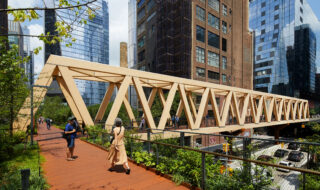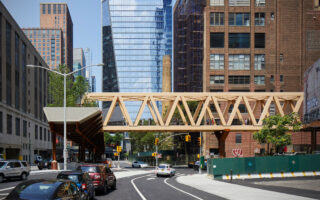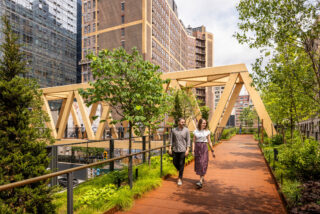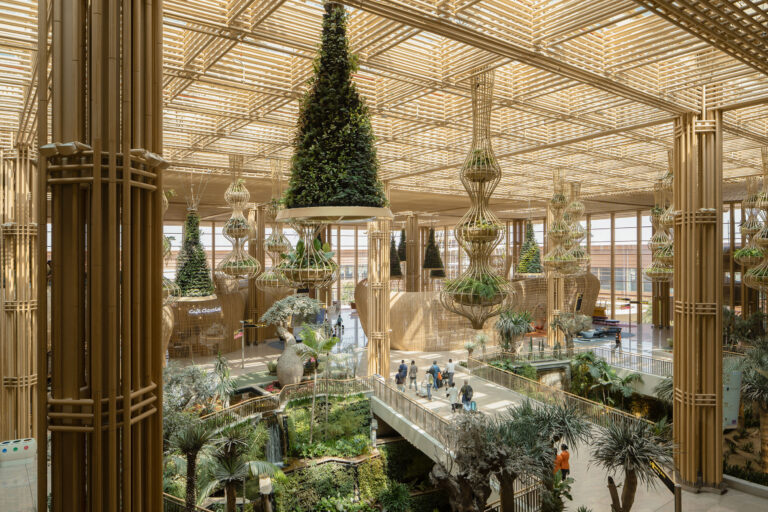In a city praised for its walkability, one section of New York City has remained hostile to pedestrians for decades. Between Moynihan Train Hall—the city’s busiest transit hub with 700,000 daily passengers—and the High Line—one of the city’s most beloved public green spaces with nearly 8 million annual visitors—lay a tangle of concrete obstacles. To get from one to the other, pedestrians had to traverse through a series of highly trafficked roads, navigate past the Lincoln Tunnel entrance, and climb up to the elevated High Line. Through a highly collaborative process, the High Line – Moynihan Connector transforms an environment dominated by cars into a safe, green pedestrian setting. The Connector is a 600-foot-long elevated walkway that connects the High Line to Moynihan Train Hall via Manhattan West Plaza with just a single street crossing. The project is part of a long-standing vision to create safer and more enjoyable pedestrian access, connect people to transit, and seamlessly link public open spaces and other community assets in the neighborhood. Running along Dyer Avenue and West 30th Street, the Connector is composed of two bridges that have their own architectural and structural expression and human experience that respond to the site and context. The 260-foot-long Timber Bridge is a glulam Warren truss, made from sustainably sourced Alaskan yellow cedar, that required minimal connections to the ground—allowing existing roads to remain undisturbed. The bridge’s Warren truss is a nod to the historic industrial character of Chelsea, reminiscent of the steel rail bridges of that era, while bringing a sustainable, contemporary aesthetic to the design with the use of renewable timber. As a durable, low-maintenance, and sustainable material, mass timber allowed the team toreduce the project’s embodied and operational carbon footprint. It is an example of one of the first timber infrastructures in Manhattan, and can serve as a catalyst for using mass timber in unexpected ways. Connecting with the High Line Spur, the 340-foot-long Woodland Bridge extends its immersive landscapes with deep and continuous soil beds, supported by architecturally exposed weathered steel columns and angled bracket arms. Extending the ecological corridor of the High Line, the bridge supports a lush landscape for birds and native pollinators, insulating from noise and wind, providing shade, and shielding pedestrians from the traffic below with a new green space. The planting shifts from high to low to create a varied experience along the bridge and allows pedestrians to see the timber structure rise over the diagonal pathway to create a visual link to the trees from Magnolia Court in ManhattanWest Plaza. This solution establishes a distinctive sense of place and guides pedestrians to their destinations on both sides of the Connector. The two bridges are aesthetically united by a warm material palette of weathered steel decking and bronze handrails, which guide pedestrians between the structures. Together, the two bridges seamlessly integrate nature into the infrastructure and urban fabric, while also creating a new pedestrian experience, promoting pedestrian safety, and enhancing ADA accessibility.
Project facts
Location New York, NY
Design Co-Leads Field Operations
Skidmore, Owings & Merrill
Year 2023
Project Team Buro Happold; Mueser Rutledge Consulting Engineers; Thornton Tomasetti; Tillotson Design Associates; Turner Construction; William Vitacco Associates; WSP
Category Transportation & Infrastructure, Landscape
AIANY Recognition
2024 AIANY + ASLANY Transportation + Infrastructure Design Excellence Awards











